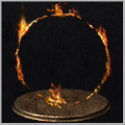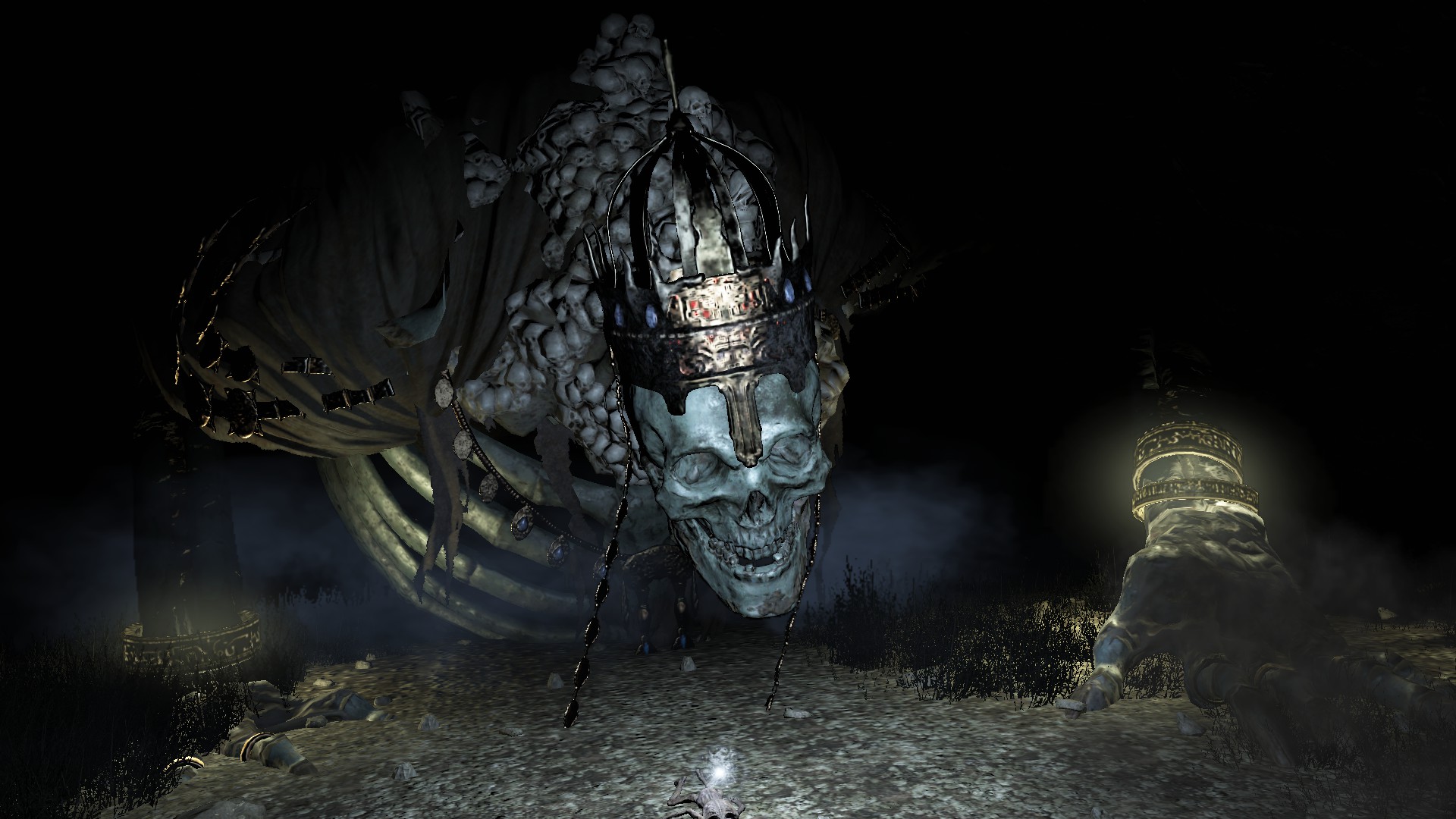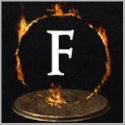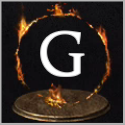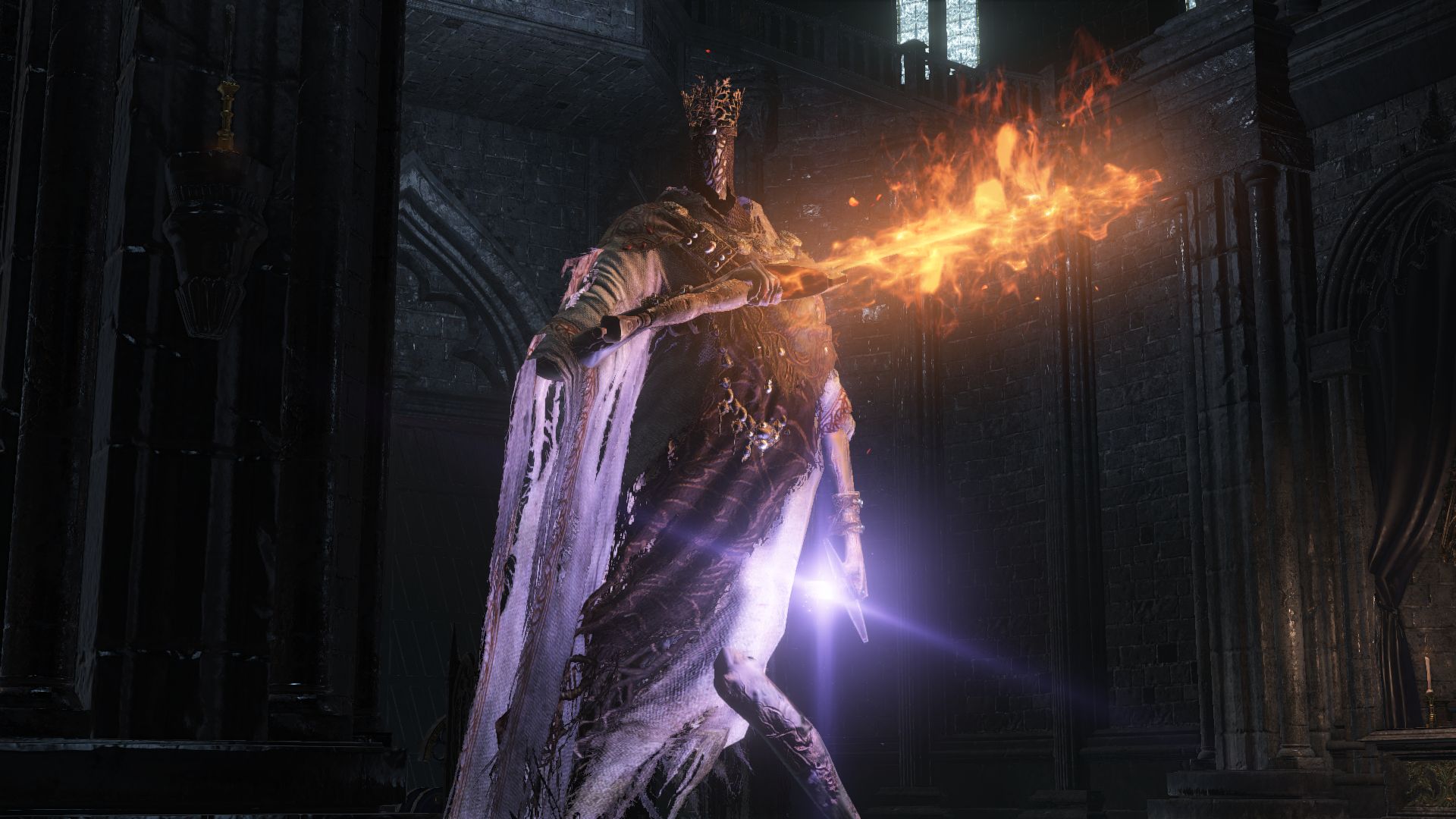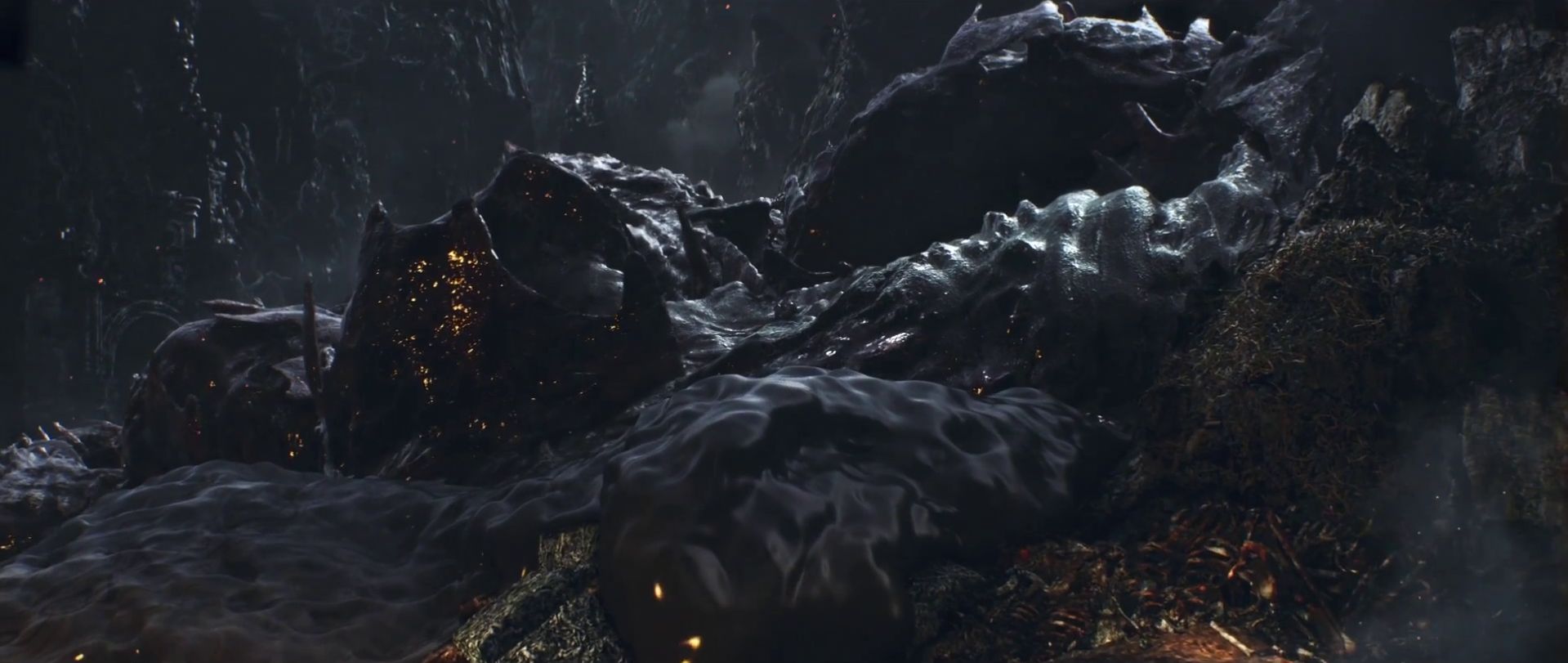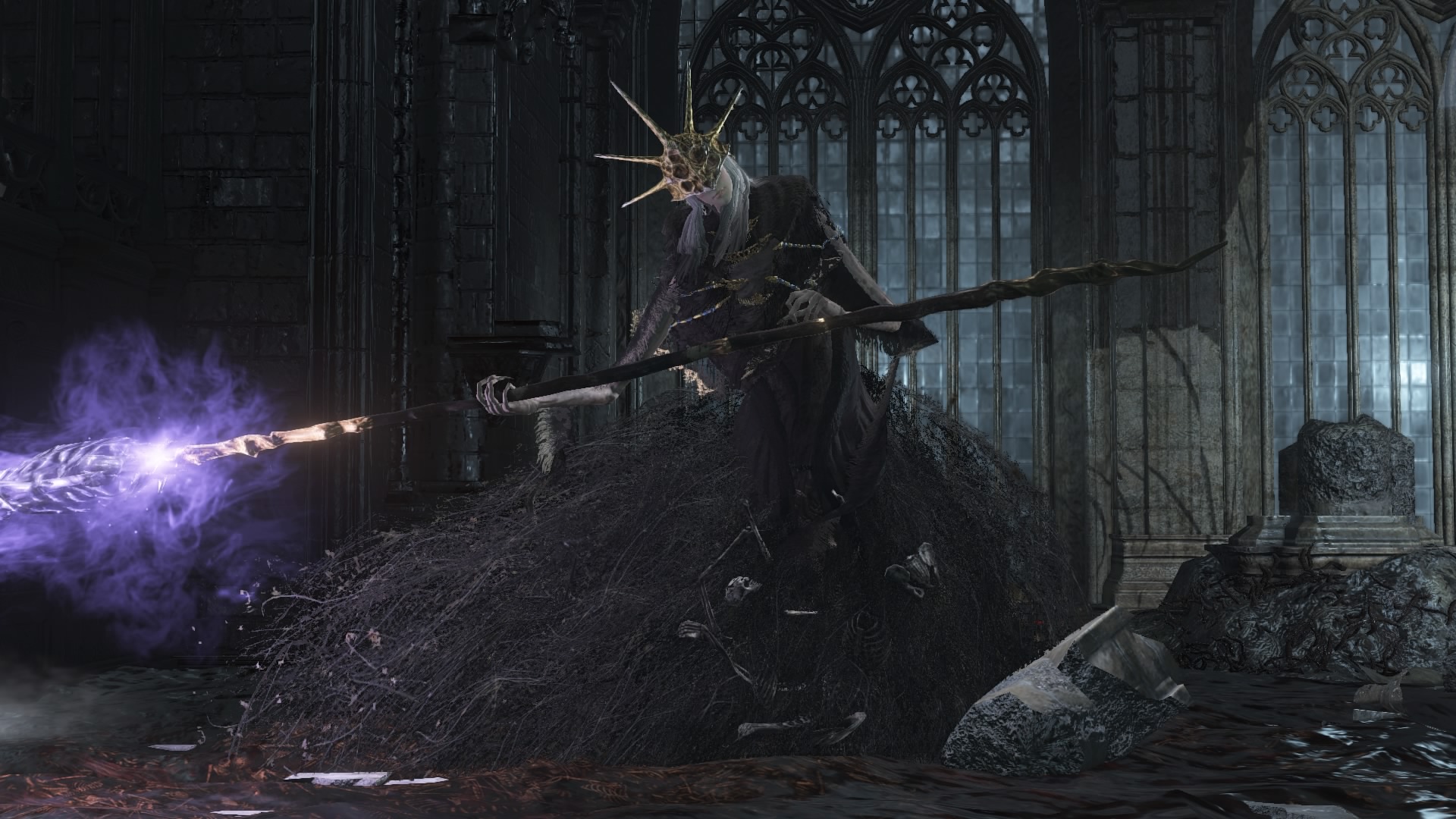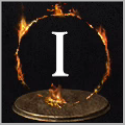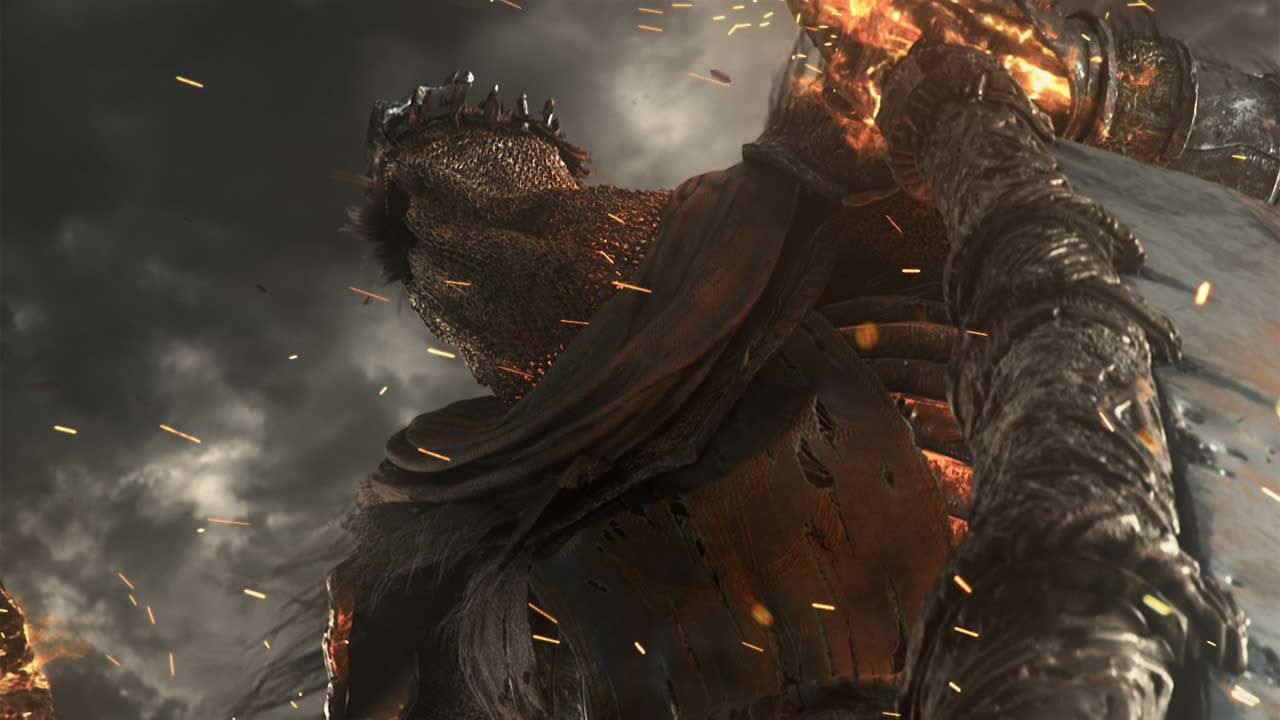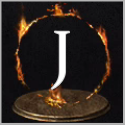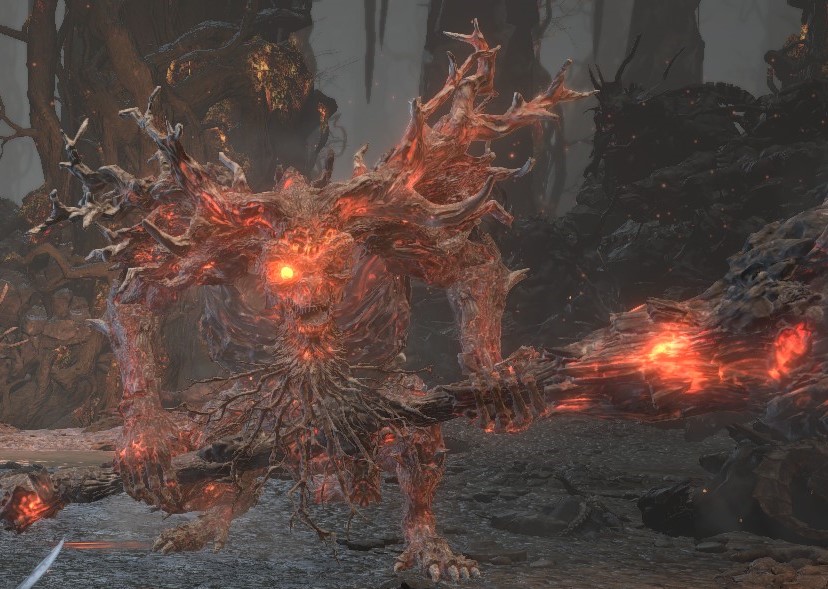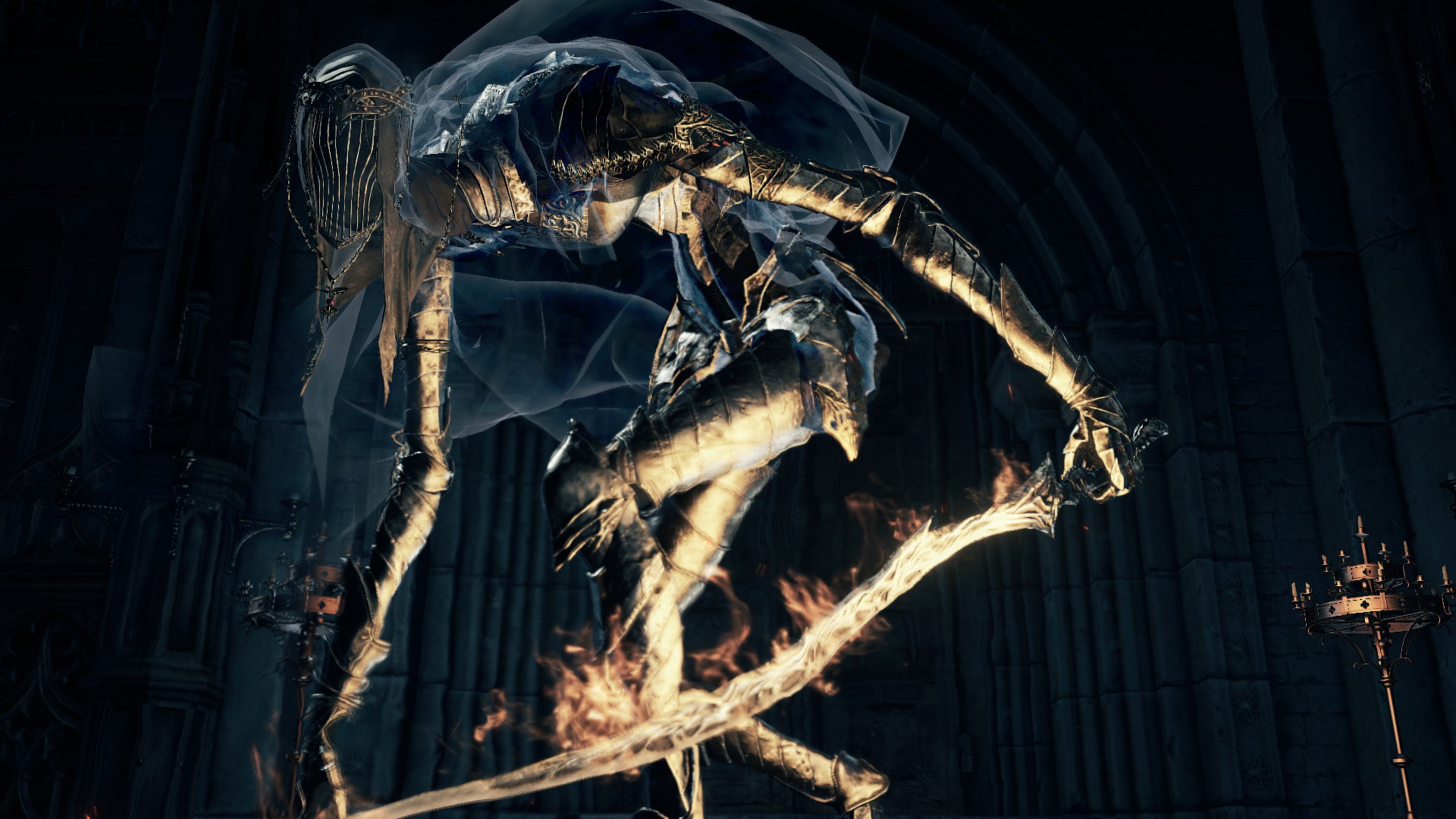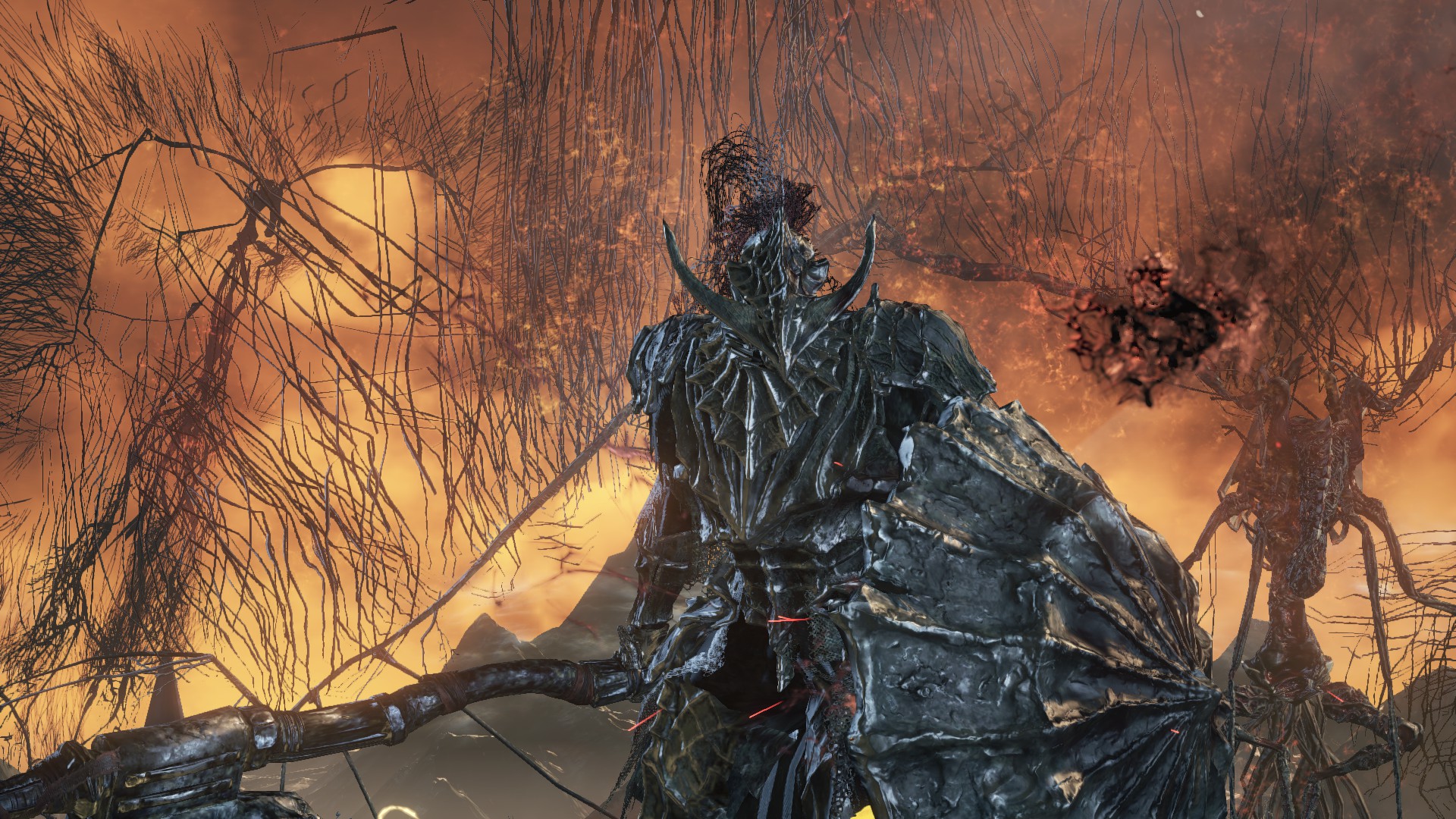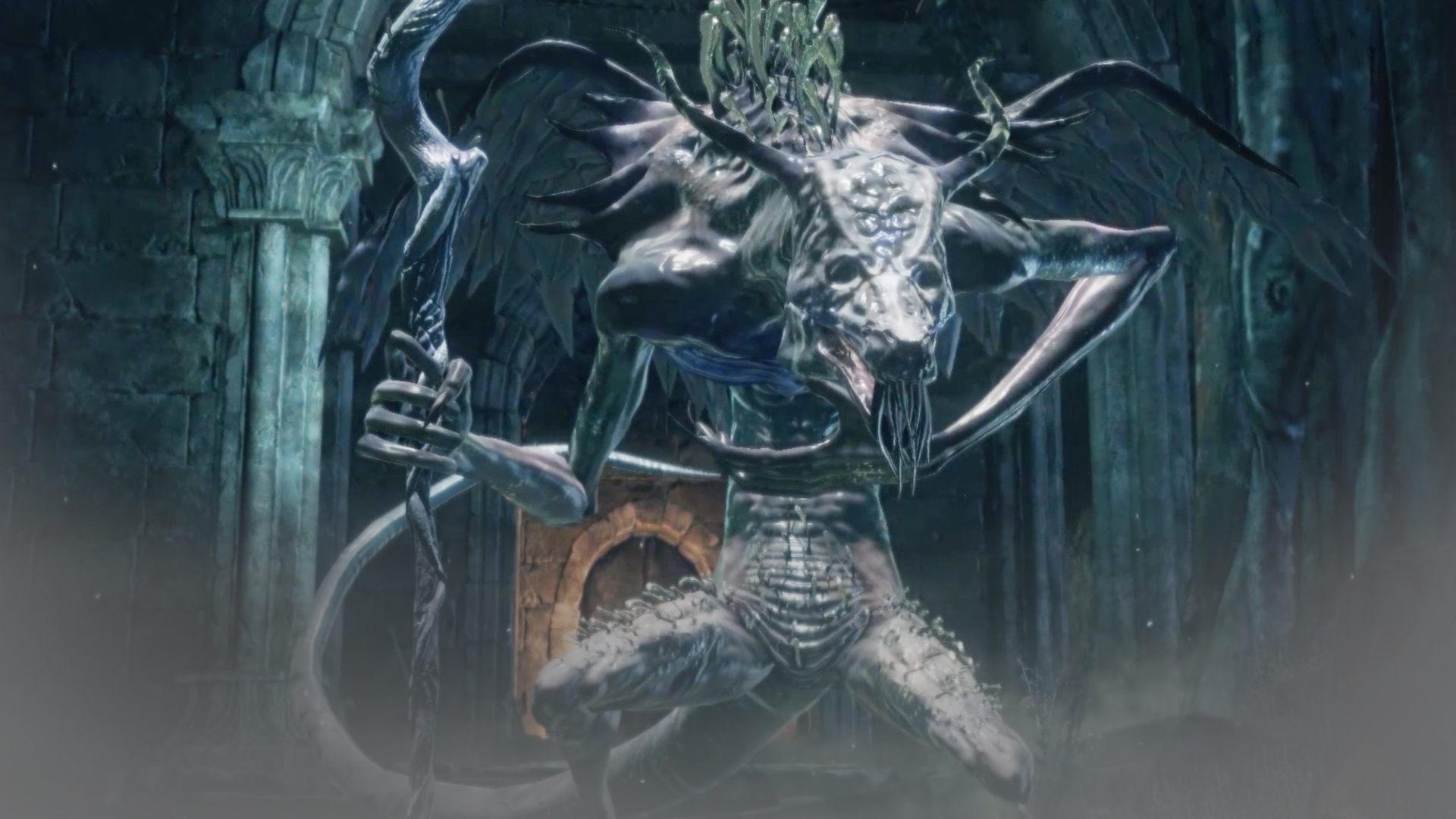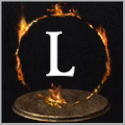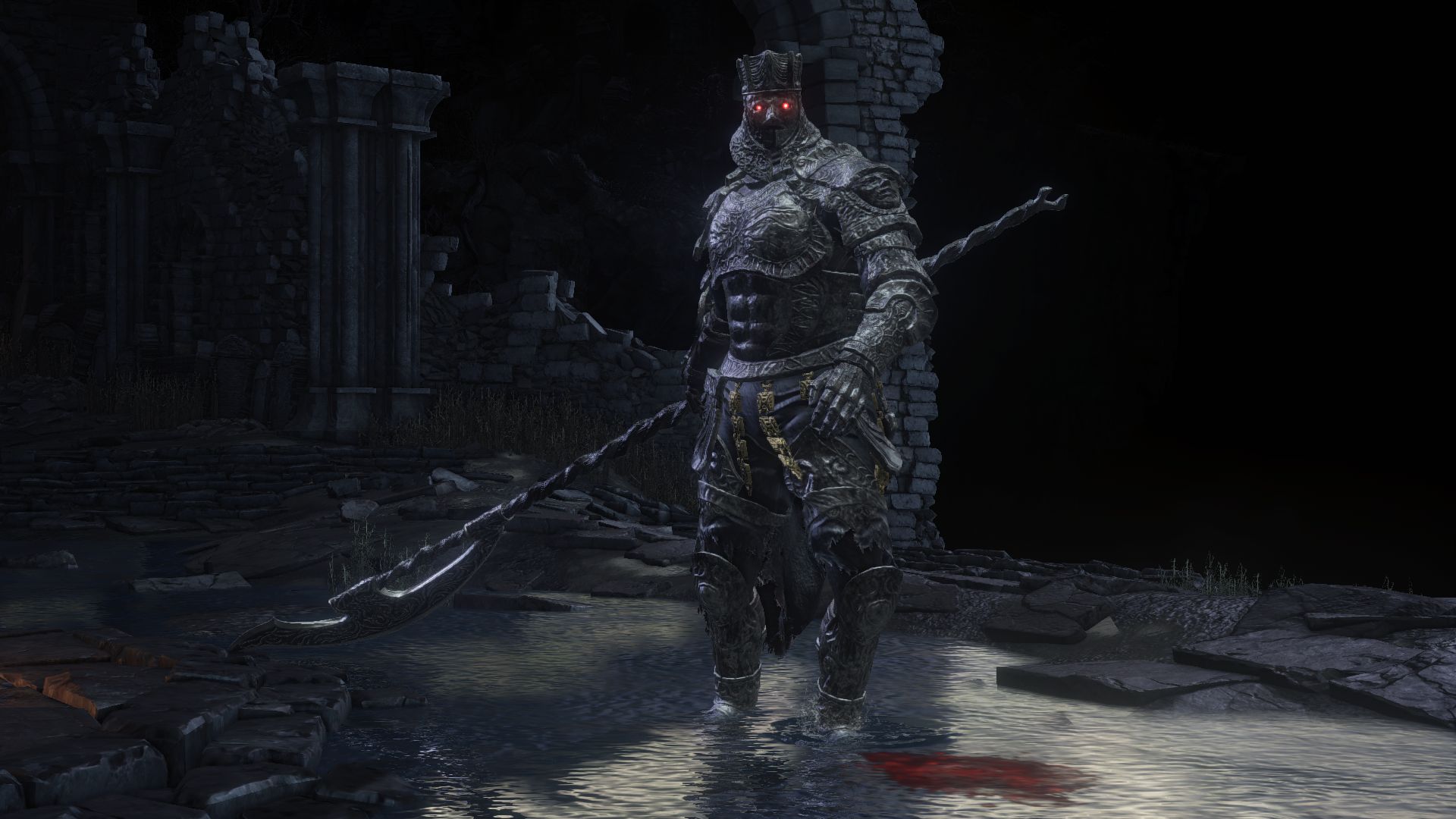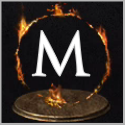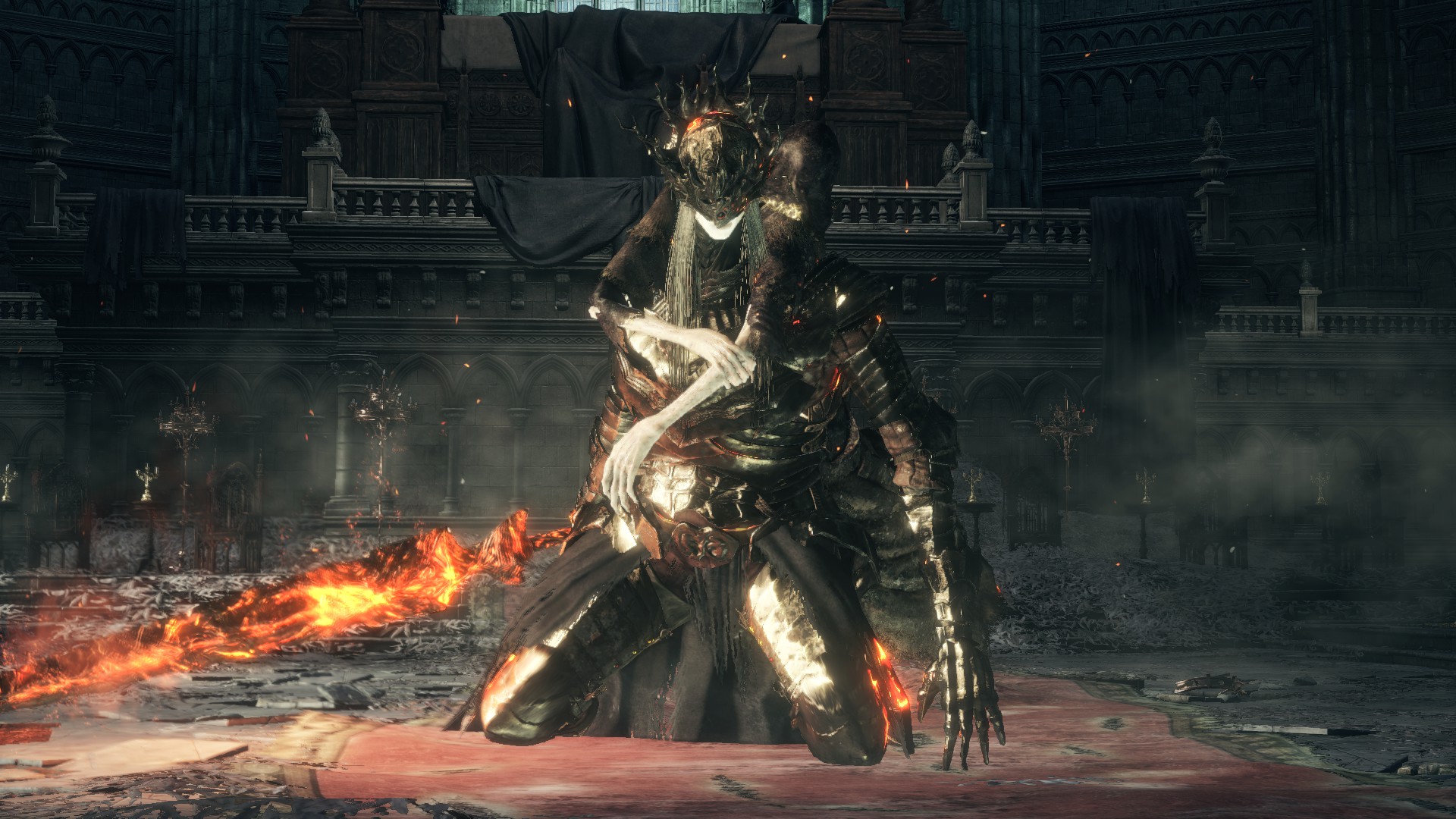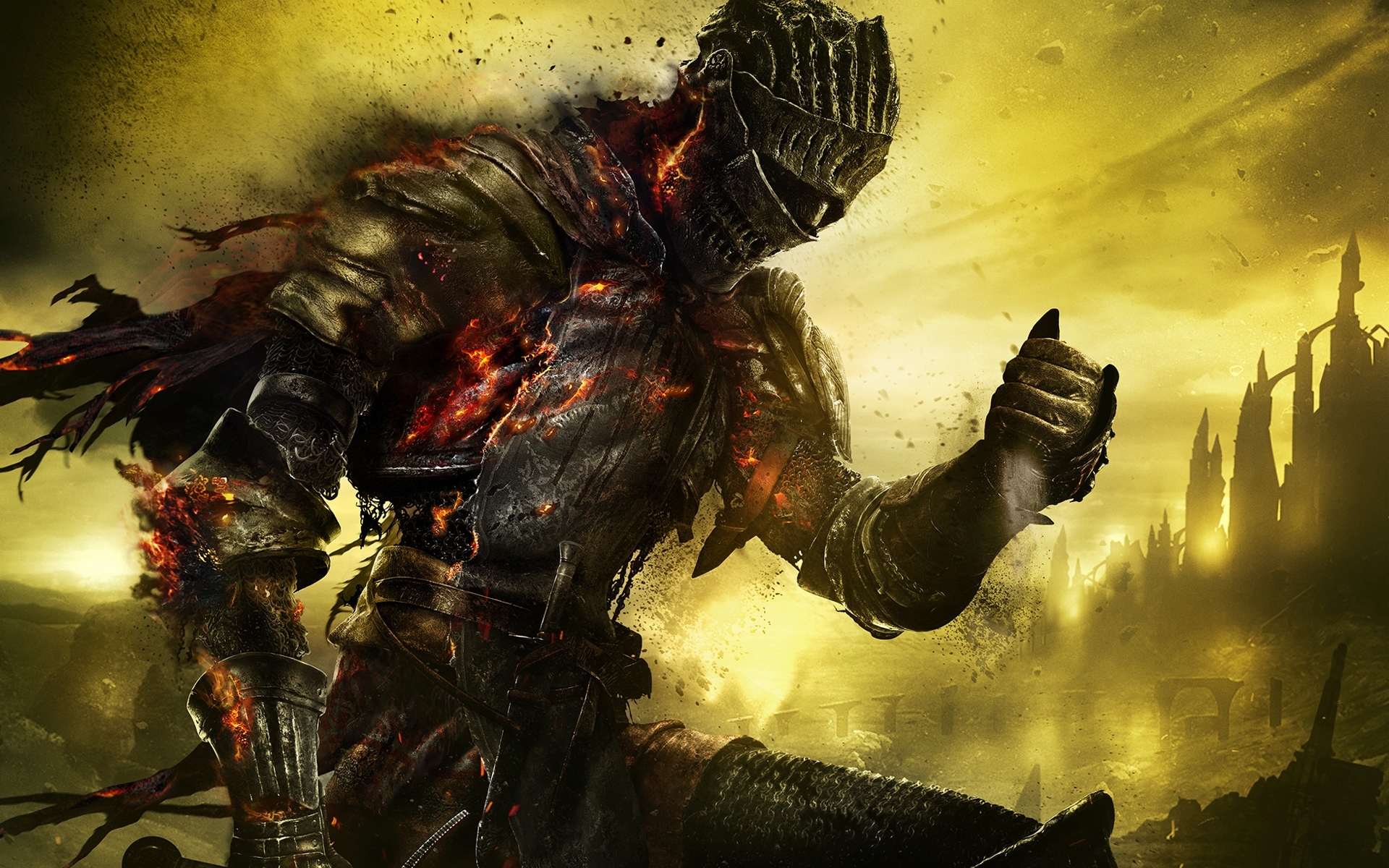



Aldrich, Devourer of Gods
With a title as metal as “Devourer of Gods” you’d expect something a bit more. He’s presented as a big all-devouring blob in the intro cinematic and I think a fight like that would be interesting. Think something like Phalanx from Demon’s Souls, only not lucicrously easy and maybe with some actual attacks instead of guarding himself with tinier versions of himself. But nah, we get a big naga-like version of Gwyndolyn, who, as far as we can tell, is still in the process of being eaten by Aldrich. I would say the slimy stuff in the arena is actually Aldrich’s body but once we kill him that substance remains, so that’s unlikely. The music is certainly reminiscent of the Moonlight Butterfly theme from Dark Souls, which was also Gwyndolyn’s theme.
While Aldrich is probbly among my least favorite boss fights in the game I would not say he’s THAT bad (It just happens that I like the game more than most people, apparently). He just has one attack that is not fun at all. I recall at the time the game came out where going on about how Aldrich is the first real villain in the Souls series (I mean, I think there’s several, but Seath is probably the best example of an actual objectively bad guy that did more than being flawed and/or doing a messed up thing once). It’s true that we’ve pursued him for the entire game until this point and the encounter has been foreshadowed by various characters and item descriptions as well as an entire area we’re led to believe he resides in. The Cathedral of the Deep. A church he founded while contemplating the fading fire when he began to receive visions of “an age of the deep sea”. An alternative to the cycle of rekindling the first flame over and over, which by this time shows diminishing returns.
What exactly the Deep is is not completely known. It could be a more extreme form of the Abyss, a Darkness without the humanity that is typically attached to the Abyss. Maybe some Cthulhu stuff, I’d dig that. Or perhaps something else entirely. I really hope that the second DLC will touch a bit more on it. What we do know is that the church that he founded in its honor had the sole purpose of feeding him more. A head figure of his church was Pontiff Sulyvahn, who had is hands in all kinds of business both related to Aldrich as well as his own endeavours. It is likely that, in addition to gods Aldrich also fed on orphans from the orphanage Anri and Horace are from, which is why they are after him. It’s also implied that Aldrich did not become a Lord of Cinder of his own will, but they forced him to fuel the first flame. Overall you could say he’s a rude, fucked up dude.
But let us talk about the fight, finally. Aldrich uses various magical attacks he can cast soul mass as well as a soul spear, which most players should be able to dodge easily. Then there’s the arrow barrage. Which goes covers the area in front of him. It’s quite devastating but can be avoided by just stepping behind him. Also a prime opportunity to get some hits in. As long as you stay close he will prefer is melee attacks, which are pretty useless all things considered, so to beat Aldrich get up in his grill and lay the smack down on him.
In phase two he gets set on fire. Which will cover the ground close to him in flames, that will damage you a bit. But the main problem with this second phase, and also the main problem I have with the fight, is his powered up arrow barrage. It no longer covers a cone in front of him. Instead the barrage homes in on you and the only way to dodge is to outrun it. Aldrich may now also cast his aforementioned spells, which you’ll also have to dodge. It’s pretty easy to get wrecked by this attack and it’s also not fun to deal with, because all you do is run. Which reinforces the fact that you should just stay close to bait his melee swings that are so easy to dodge you probably do it by accident at least once. Get in his face and go murdertown. Use fire if you have to, he happens to be weak to fire despite being on fire. An old Souls tradition.
He can be a bit random but as long as you stay close you’ll minimize the chance of him using one of his actually dangerous attacks.

Cinders of a Lord (Aldrich)
Cinders of a lord left by Aldrich, Devourer of Gods.
If the lords will not return to their thrones themselves, let them return as cinders.
Aldrich became a lord by devouring men, but was disillusioned with his throne, and so took to devouring gods instead.
Soul of Aldrich
Soul of Aldrich,
One of the twisted souls, steeped in strength.
Use to acquire many souls, or transpose to extract its true strength.
When Aldrich ruminated on the fading of the fire, it inspired visions of a coming age of the deep sea.
He knew the path would be arduous, but he had no fear. He would devour the gods himself.
Darkmoon Longbow
Dark Souls III:
Longbow of Darkmoon Gwyndolin, who was gradually devoured by Aldrich. This golden bow is imbued with powerful magic and is most impressive with Moonlight Arrows.
Skill: Darkmoon Arrow - Infuse a readied arrow with Darkmoon essence, granting it magic damage and the ability to pierce shields.
Dark Souls (As Darkmoon bow, a short bow):
Bow born from the soul of the Dark Sun Gwyndolin, Darkmoon deity who watches over the abandoned city of Gods, Anor Londo.
This golden bow is imbued with powerful magic and is most impressive with Moonlight Arrows.
Lifehunt Scythe
Dark Souls III:
Miracle of Aldrich, Devourer of Gods.
Steals HP of foes using an illusory scythe.
Aldrich dreamt as he slowly devoured the God of the Darkmoon. In this dream, he perceived the form of a young, pale girl in hiding.
Dark Souls (as an actual equippable weapon):
cythe born from the soul of Priscilla, the stark white crossbreed trapped inside the Painted World of Ariamis.
Even the Gods feared Priscilla’s lifehunt ability, and in the hands of a mortal, its power will turn upon its wielder.
Human Dregs
Proof of a duty fulfilled by the Aldrich Faithful, who patiently await the Devourer of Gods’ return.
Dregs are the heaviest things within the human body, and will sink to the lowest depths imaginable
Aldrich’s Ruby
A malformed ring left by Aldrich, Saint of the Deep. Recovers HP from critical attacks.
Aldrich, infamous for his appetite for flesh apparently had the desire to share with others his joy of imbibing the final shudders of life while luxuriating in his victim’s screams.
Soul of Pontiff Sulyvahn
Soul of Pontiff Sulyvahn.
One of the twisted souls, seeped in strength.
Use to acquire many souls, or transpose to extract its true strength.
Pontiff Sulyvahn of Irithyll imprisoned a god of the old royalty in the abandoned cathedral, to be fed to the devourer.
Greatsword of Judgment
A ceremonial sword, held in Pontiff Sulyvahn’s left hand, respresenting the judgement of the moon, but with magic far closer to sorcery than any existing lunar power. Its dark blue hues, deeper than the darkest moon, reflect sorcerer Sulyvahn’s true nature.
Skill: Stance of Judgment - Assume stance to unleash dark magic. Use normal attack for a lunging thrust, and strong attack to emite side-sweeping wave.
Profaned Greatsword
A ceremonial sword, held in Pontiff Sulyvahn’s right hand, representing the Profaned Flame.
Long ago, when Sulyvahn was yet a young sorcerer, he discovered the Profaned Capital and an unfading flame below a distant tundra of Irithyll, and a burning ambition took root within him.
Skill: Profaned Flame - Temporarily summon the Profaned Flame. Lunge forward and use strong attack to enshroud blade in flame.
Pontiff’s Right Eye
Bewitched ring that Pontiff Sulyvahn bestowed upon his knights.
Boosts attacks, as long as attacking persists.
Knights who peer into the black orb are lured into battles of death, transformed into frenzied beasts. No wonder the Pontiff only provides these rings to those dispatched to foreign lands.
Smough’s Great Hammer
Dark Souls III:
Twisted great Hammer associated with Smough, the last knight to remain at his post, guarding the ruined cathedral.
Restore HP while attacking, a carryover from Smough’s past as an executioner.
Skill: Perseverance - Anchor weapon in earth to temporarily boost poise. Damage reduced while activated.
Dark Souls:
Great hammer from the soul of executioner Smough, who guards the cathedral in the forsaken city of Anor Londo.
Smough loved his work, and ground the bones of his victims into his own feed, ruining his hopes of being ranked with the Four Knights.
Leo Ring
Dark Souls III:
Ring associated with Dragon Slayer Ornstein, one of the Four Knights of Gwyn, the First Lord.
Strengthens thrust weapon counter attacks.
Ornstein was the first knight of the sun’s eldest born, and his cross spear is said to have pierced scales made of stone.
Dark Souls II (Old Leo Ring):
The beloved ring of a dragon-slaying knight.
Strengthens thrust weapon counter attacks.
After many years of use, the ring’s face has worn down, but close inspection reveals an engraved lion.
Dark Souls:
One of the special rings granted to the four knights of Gwyn. The Leo Ring belonged to Ornstein the Dragonslayer.
This ring strengthens counters with pierce weapons. His lugged spear is said to have sliced a boulder in two.
Golden Ritual Spear
A ritual spear presented to Darkmoon Knights before Sulyvahn claimed the title of Pontiff.
Can also be used as a staff. Sorceries cast using this weapon channel the wielder’s faith.
Skill: Steady Chant - Boost the strength of sorceries for a very short period.
Dorhy’s Gnawing
Miracle of Dorhys the deranged evangelist.
Summons great insect swarm to feast on foes.
Those who linger too long on the brink of the Deep will often slip. Dorhys is sure to have wallowed in this darkness, intoxicated by its peril.
Witchtree Branch
The branch of a large, well-tended witchtree, used as a sorcery catalyst.
Witchtree staves are customary in the far north, and allow for faster casting than ordinary catalysts.
Skill: Steady Chant - Boost the strength of sorceries for a very short period. Works while equipped in either hand.
Yorshka’s Spear
This treasure, gifted to the Yorshka Church, is enchanted with a soporific spell, and was surreptitiously worshiped by Irithyll slaves.
As a weapon, it is part spear and part hammer, the former allowing thrusting, and the latter allowing strikes.
Skill: Pacify - With a prayer and an offering of this spear, temporarily wear down enemy FP with each strike.
Drang Twinspears
Paired spears of the Drang Knights, proclaimed descendants from the land known for the legend of the Linking of the Fire. When the Drang Knights disbanded, they scattered across the lands as sellswords. They quickly became known for shieldless, aggressive tactics that struck fear in the hearts of men.
Skill: Charge - Hold spear at waist and charge at foe. Use strong attack while charging to extend the length of the charge.
Dragonslayer’s Greatbow
Dark Souls III:
Greatbow used by the Dragonslayers during the age of gods. Far greater in size than any normal bow, and far more devastating.
The bow must be anchored in the ground to be fired, a time consuming operation that leaves the operator vulnerable. Only specialized great arrows can be fired from the bow.
Skill: Puncturing Arrow - Masterfully fires off a great arrow that pierces through all enemies in its path, inflicting damage.
Dark Souls II:
A greatbow said to be used to down ancient dragons flying high above the clouds.
Extremely large for a mere bow, and more destructive than any ranged weapon imaginable.
Shooting this bow requires the grounding of its stability anchor, which takes time and leaves the shooter vulnerable.
Also requires great arrows.
Dark Souls:
Bow of the Dragonslayers, led by Hawkeye Gough, one of Gwyn’s Four Knights.
This bow’s unusual size requires that it be anchored to the ground when fired. Only uses specialized great arrows.
Painting Guardians Curved Sword
A weapon described in legends passed down amongst heretics, wielded by the Painting Guardians.
A uniquely shaped weapon with a flat tip.
Skill: Chained Dance - Execute relentless consecutive attacks while tracing a circle in a unique dance of deadly grace.
Painting Guardian Set
Dark Souls III:
Attire of the Painting Guardians, whose forms are described in the mythology of heretics.
A smooth pale hood that deters magic.
The hunchbacked teller of ancient tales describes unwanted souls who are unwelcome across the lands, and are eventually drawn into a cold, painted world.
Dark Souls II (Monastery Set):
Traditional sacred attire crafted at
the Lindelt Monastery. Made of a lightweight, flowing white fabric.
The ceremonial design suggests that they revered whatever it was they watched over.
The purity of the garment, however, neatly symbolizes the fraudulence found at the very heart of the monastery.
Dark Souls:
Apparel worn by the alabaster-clothed guardians of the paintings in Anor Londo. Offers substantial protection versus magic.
They have guarded the Great Paintings of Ariamis for ages, passing their duty down through the generations, but the reason for doing so passed from all memory long ago.
Brass Set
Dark Souls III:
Armor of a knight once known as the Darkmoon. It is said that this brass armor hides something hideous within.
Something about its silhouette suggests femininity.
Dark Souls:
Armor of the Darkmoon Knightess, Fire Keeper of Anor Londo.
After becoming Undead, she visited the Dark Sun Gwyndolin at the Mausoleum of the Spiral Depths, became a Blade of Darkmoon, and assumed the flame-keeping duty. She received this armor, which hides her hideous form and helps her hunt the guilty.
Silver Knight Set
Dark Souls III:
Armor of the Silver Knights allegiant to the royals of old.
It is said that even after the family’s passing, the knights continued to watch over their manor, and the ruined cathedral.
Dark Souls:
Armor of the Silver Knights who protect Anor Londo.
When Lord Gwyn departed to link the Fire, his knights split into two groups. The Silver Knights remained in the forsaken capital in the service of their goddess.
Magic Clutch Ring
Dark Souls III:
Ring depicting a hand grasping a blue stone. Increases magic attack, but compromises damage absorption.
An old fable in Londor claims that the lure of the clutch ring reaches out to the crestfallen, who might otherwise be overcome by despair.
Dark Souls II:
Ring depicting a hand grasping a stone. Increases magic attack, but reduces physical defense.
The origin of this ring is unknown, but its design suggests one of the darker deities. Effective use of this ring requires skill on the part of the wearer.
Ring of the Sun’s First Born
Dark Souls III:
Ring of the Sun’s first born, who inherited the light of Gwyn, the first lord. Greatly boosts miracles.
The Sun’s first born was once a god of war, until he was stripped of his stature as punishment for his foolishness. No wonder his very name has slipped from the annals of history.
Dark Souls:
Lord Gwyn’s firstborn, who inherited the sunlight, once wore this ancient ring. Boosts the strength of miracles.
Lord Gwyn’s firstborn was a god of war, but his foolishness led to a loss of the annals, and rescinding of his deific status. Today, even his name is not known.
Sun Pricnes Ring
Dark Souls III:
Ring associated with Gwynevere, princess of sunlight and eldest daughter of Gwyn, the First Lord.
The ring is vaguely warm, like a beam of sunlight, and gradually restores HP.
Gwynevere left her home with a great many other deities, and became a wife and mother, raising several heavenly children.
Dark Souls:
This ring is granted to those who enter a Covenant with Gwynevere, daughter of Lord Gywn and the Princess of Sunlight. This slightly warm ring boosts the synergy of miracles.
The Princess of Sunlight Gwynevere left Anor Londo along many other deities, and later became wife to Flame God Flann.
Ring of Favor
Dark Souls III :
A ring symbolizing the favor of the Goddess Fina, whose “fateful beauty” is mentioned in legend.
True to the fickle nature of Fina’s favor, her ring increases max HP, stamina, and maximum equip load.
Dark Souls:
A ring symbolizing the favor and protection of the goddess Fina, known in legend to possess “fateful beauty”.
This ring boosts its wearer’s HP, stamina, and max equipment load, but breaks if ever removed.
Proof of a Concord Kept
Dark Souls III:
Blood-drained, shrunken ear. Souvenir taken for subduing the guilty.
The knights called the Blades of the Darkmoon punish the guilt-soaked offenders of the Gods and take this proof of their conquest. The earless corpses of the guilty will be left behind as a warning to others, inspiring both fear and respect for the Gods. Such is the eternal mandate of the Dark Sun.
Dark Souls (Souvenir of Reprisal):
Blood-Drained, shrunken ear. Souvenir taken for subduing the guilty.
The knights called the Blades of the Darkmoon punish the guilt-soaked offenders of the Gods and take this as proof of their conquest. The earless corpses of the guilty will be left behind as a warning to others, inspiring both fear and respect for the Gods. Such is the eternal mandate of the Dark Sun.
Proof of a Concord Well Kept
Distinguished proof that one has hunted the enemies of the gods, as per the ancient accord with the Way of Blue.
The layered ear of a dark spirit is the mark of a particularly guilty offender, one who has flagrantly violated one god or another.
Use to acquire two Proofs of a Concord Kept.
Roster of Knights
Online play item. A roster of knights of the Darkmoon who have served since the age of the old Royals.
Use to discover the names of Darkmoon Knights, an order of elite knights shrouded in shadows.
Giant’s Coal
Coal used for weapon infusion.
It is said that the giant blacksmith of Anor Londo was once the blacksmith of the gods.
Give to the blacksmith in the shrine to allow the use of gems for lightning, simple, and chaos infusion.
Greirat’s Ashes
Umbral ash of Greirat of the Undead Settlement. With this, the shrine handmaid will prepare new items.
Greirat was a thief who fancied himself a martyr for the poor, which is what drove him to climb the wall.
Note: this will only appear if Greirat actually dies in Irithyll
Excrement-Covered Ashes
Unclean umbral ash coated with excrement. Perhaps it’s possible the handmaid of Firelink Shrine could turn this into a few new things…
“Oh to savor the sweet pungency but once more…”
Easterner’s Ashes
Umbral ash of an armor merchant from an eastern land.
Surely the handmaid of Firelink Shrine can turn this into a few new things.The merchant, the captain of a clan of hunters, was fascinated with weaponry.
![]()

